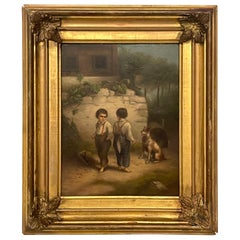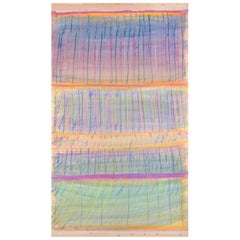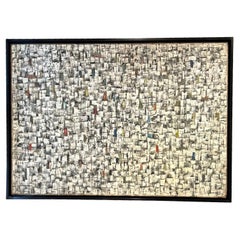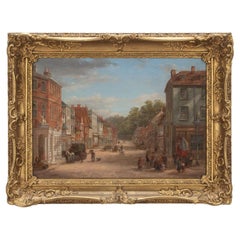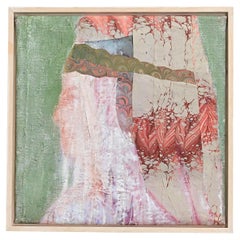European Paintings
to
1,338
5,466
4,034
8,985
586
276
Height
to
Width
to
1,089
966
396
391
366
147
138
89
84
68
59
48
43
41
33
29
18
5
1,053
2,603
5,327
862
1,098
2,040
1,392
128
80
205
247
167
296
545
494
235
199
4,701
4,502
3,371
3,170
1,239
9,847
6,442
5,689
2,918
1,582
9,847
9,794
9,831
93
68
27
23
21
Place of Origin: European
19th Century French Painting 'Backyard Fight', Unsigned
Located in West Palm Beach, FL
19th century French Painting 'Backyard Fight', Unsigned
France, later 19th century
Oil on Board, Apparently unsigned.
This 19th-century French painting, titled 'Backyard Fight,' i...
Category
Late 19th Century Sporting Art Antique European Paintings
Materials
Wood, Giltwood
$1,200 Sale Price
20% Off
Monique Beucher. Gouache on paper. Abstract composition. Colorful palette.
Located in København, Copenhagen
Monique Beucher (1934), French artist.
Gouache on paper mounted on canvas.
Abstract composition. Colorful palette.
From the 1980s.
In perfect condition.
Exhibited at "La Galerie" 67 ...
Category
1980s Vintage European Paintings
Materials
Canvas, Paper
Black and White Extra Large Painting by Derek Middleton, England, 1963
Located in New York, NY
1963 English artist Derek Middleton ( 1928 - 2002 ) extra large black and white painting
with accents of rectangular shaped color.
Can b...
Category
1960s Vintage European Paintings
Materials
Other
19th Century Oil on Canvas of Reigate, Surry
Located in Shipston-On-Stour, GB
A well executed 19th Century oil on canvas of an active street scene of Bell Street in Reigate.
Colourful and finely detailed building of the White Hart, the Bell Pub and houses, wit...
Category
Mid-19th Century Country Antique European Paintings
Materials
Canvas, Giltwood, Paint
Dutch Mixed Media Lady
Located in Baton Rouge, LA
A recently made painting of a lady by an unknown Dutch artist. The mixed media collection of materials on canvas depicts a lady's face and is framed in a simple wood frame. Be sure t...
Category
21st Century and Contemporary Modern European Paintings
Materials
Wood, Paint
An Antique English Oil on Canvas Depicting a noble man and women by W. Gozzard
Located in Los Angeles, CA
An Antique English Oil on Canvas Depicting a noble man and women by W. Gozzard
Maker: Walter Gozzard (1888-1950).
Category
19th Century Antique European Paintings
Italian Landscape in the Manner of Vernet
Located in Greenwich, CT
18th century oil on canvas of a Mediterranean harbor scene, in the manner of Claude Vernet (1714-1789) depicting a fanciful scene with castles and villas...
Category
1750s Rococo Antique European Paintings
Materials
Canvas, Giltwood, Paint
Mid Century Modern Danish Abstract Painting, signed and dated 1968
Located in Ventura, CA
Mid-Century Modern Blue Abstract Painting 1968
This panting is a captivating piece from the Danish art scene, characterized by its striking use of various shades of blue. Signed by ...
Category
1960s Mid-Century Modern Vintage European Paintings
Materials
Canvas
David Bautz 'Dutch' Oil Portrait of a Young Mother and Child, circa 1920
Located in San Francisco, CA
Early 20th century Dutch oil portrait of a young mother and child by David Bautz (Dutch, 1884-1955).
A fine oil portrait, circa 1920s.
A young mother breast feeding...
Category
Early 20th Century European Paintings
Materials
Walnut
Italian 19th Century Oil on Canvas Painting
Located in West Palm Beach, FL
A beautiful Italian 19th century oil on canvas painting. The painting depicts a beautiful Italian scene of personages going about their day with charming boats and a house on the wat...
Category
19th Century Antique European Paintings
Materials
Canvas, Giltwood
Landscape "Road with Cypress and Star"
Located in Queens, NY
Copy of an impressionist vertical landscape painting titled "Road with Cypress and Star"
Category
Late 20th Century Biedermeier European Paintings
Materials
Paint
Pair of 19th Century Portraits by C. Stoitzner, Austria
By Konstantin Stoitzner
Located in Casteren, Noord-Brabant
A couple of paintings, depicting two men dressed in the fashion of the Renaissance.
Oil paint on panel. The frames are carved and gilded with gold leaf. Here and there some small pieces of gold leaf are missing.
Below you will find more detailed information about the artist Constantin Stoitzner...
Category
1890s Renaissance Revival Antique European Paintings
Materials
Oak
"St. Sebastian in Gold and Coral", Striking Art Deco Painting by Remy, France
Located in Philadelphia, PA
A vivid and striking example of Art Deco painting, this depiction of St. Sebastian in tones of gold and pink-papaya shows the figure with a rich, brown complexion, wounded with four ...
Category
1920s Art Deco Vintage European Paintings
Materials
Paint
Large Painted Oval Wooden Wall Panel from Florence, Italy
Located in Dallas, TX
Hand-painted in Florence, Italy, this fantastic oval wooden wall panel features a large urn with a scrolled handle. The urn is adorned with a fluted...
Category
21st Century and Contemporary European Paintings
Materials
Wood, Paint
Oil on Canvas: 'a Fisherman with His Pipe'
Located in LA CIOTAT, FR
Portrait of 'A Fisherman with his Pipe' in oil on canvas, within a finely moulded giltwood frame. The painting is signed on the lower left hand side – possibly by an artist named Ple...
Category
Early 20th Century European Paintings
Materials
Canvas
Early 20th Century Water Colour - Flowers - by Corneille Henri Dee
Located in Casteren, Noord-Brabant
A beautiful antique work of art by the Dutch painter Corneille Henri Dee.
The painting shows an abundance of floral splendor, wisteria and delphinium.
Watercolor on paper. Made aro...
Category
Early 1900s Art Nouveau Antique European Paintings
Materials
Paper
French Late 20th Century Framed and Signed Oil on Canvas Barnyard Scene Painting
Located in Atlanta, GA
A French framed oil on canvas painting from the late 20th century, titled "Barnyard Scene". Created in France during the later years of the 20th century, this oil on canvas painting ...
Category
20th Century European Paintings
Materials
Canvas, Paint
Large Nude Painted Bas-Relief by Eric Satchwell, 1973
Located in St Annes, Lancashire
Wonderful painting of nudes titled "Oreades".
Oil paint on gesso relief. On board.
Great colors and technique.
Painted in an Art Deco style. It ...
Category
1970s Art Deco Vintage European Paintings
Materials
Gesso
Robert Cleminson 19th Century Landscape Oil Painting with Horse and Dogs
By Robert Cleminson
Located in Atlanta, GA
19th century English oil painting by Robert Cleminson. This highland scene from British painter Robert Cleminson (1864-1903) features a landscape scene with a horse and three dogs. T...
Category
19th Century Antique European Paintings
Materials
Canvas
1940's Still Life oil on board painting by Paul Petit
Located in New Orleans, LA
A still life oil painting on board framed in distressed wood, signed Paul Petit 1885-1960
Category
Mid-20th Century European Paintings
Materials
Paint
Italian Oil on Canvas Painting of Venice, circa 1830 in Original Giltwood Frame
Located in Atlanta, GA
This Italian oil on canvas painting of Venice was made in the early 19th century. Featuring one of the most striking Venetian scenes, the Grand Canal, the artist was probably near th...
Category
19th Century Antique European Paintings
Materials
Canvas, Paint
18th Century French Port Scene Oil Painting from Provence
Located in Dallas, TX
Sharing similarities of a mid-17th-century Italian capriccio painting, this French oil painting from Provence depicts fantastical architecture set amongst the more realistic setting ...
Category
18th Century Antique European Paintings
Materials
Canvas, Wood, Giltwood, Paint
19th Century Beaux Arts Period Mural Style Painting
Located in San Francisco, CA
A late 19th century Baroque revival style Beaux Arts period oil on canvas laid down on board. Most likely this was part of a larger mural at one time.
Elaborate still life, beautifu...
Category
Late 19th Century Beaux Arts Antique European Paintings
Materials
Canvas
Large 18th Century Italian Oil On Canvas Painting Of Christ
Located in London, GB
A large scale (life size) 18th Century Italian oil on canvas.
'THE BODY OF THE DEAD CHRIST IN THE TOMB' after Hans Holbein the Younger, showing Christ lying in the tomb. His head re...
Category
18th Century Folk Art Antique European Paintings
Materials
Canvas, Paint
Antique Signed Brandsma Belgium Oil on Canvas Painting of Young Boy Part Set
Located in West Sussex, Pulborough
We are delighted to offer for sale this lovely original circa 1930s Belgium oil on canvas of young boy in a cap which is part of a suite
I have seven of these lifestyle, natural D...
Category
1930s Art Deco Vintage European Paintings
Materials
Canvas
Original Oil on Canvas Painting of Coastal Sunset, Signed and Dated 1918 by Albe
Located in Round Top, TX
Original oil on canvas laid on board, coastal scene with vibrant sunset.
Signed and dated AW, 1918.
Artist: Albert Wang (b. Horsens 1864, d. Hellerup 1930)
Condition: May benefit from surface cleaning. Minor retouches.
Please refer to professional photos to clearly understand finish, details, condition, etc.
With over 37 years of experience selling European antiques, our brick-and-mortar storefront, Round Top Ranch...
Category
Early 20th Century European Paintings
Materials
Canvas, Paint
Early 20th Century Oil Painting - Flower Still Life - Roses - Moreau 1939
Located in Casteren, Noord-Brabant
A beautiful old oil painting, a flower still life, roses in a vase. Very skillfully painted, the roses look lifelike. In addition, beautiful everyday attributes in the foreground, a ...
Category
1930s Vintage European Paintings
Materials
Paint
Franco-German 19th Century Oil on Canvas "Portrait of a Lady" in Giltwood Frame
Located in Los Angeles, CA
A fine Franco-German 19th century oil on canvas "Portrait of a Lady" depicting an 18th century young beauty posing with a profile gaze and cur...
Category
19th Century Louis XV Antique European Paintings
Materials
Gesso, Canvas, Wood
$9,850 Sale Price
33% Off
Unknown, Folksy Scenery with Cattles, Goats and Farmer's Wifes, Ca. 1900s
Located in Berghuelen, DE
Oil painting folksy scenery with cattles, goats and farmer's wifes, ca. 1900s
A colorful antique oil painting depicting a bavarian farmers family with their cattles and goats. The scene is located beside an mountain lake in the alpine landscape. Oil on canvas late 19th century. Framed with wooden richly handcarved Black Forest frame. Paint partly with craquelure and peeled off (see detail pictures). A great addition to every folksy wall decor.
Alpine oil painting...
Category
Late 19th Century Biedermeier Antique European Paintings
Materials
Canvas, Wood
18th Century French Pair of Oils on Gold Leaf Panels
Located in North Miami, FL
18th century French pair of oils on gold leaf panels. One is depicting an angel playing the violin, and the other one is holding the music book.
Category
18th Century Baroque Antique European Paintings
Materials
Gold Leaf
Michael O'Connell, sunbathing, Wall Hanging, Painting on Woven Fabric, 1950s UK
Located in London, Fitzrovia
"sunbathing", a unique wall hanging.
Paste resist painting on a thick woven fabric, by Michael O'Connell, mid century, UK.
An impressive piece.
Michael O'Connell (1898 – 1976) was an English modernist artist who worked in Australia between World War I and World War II and then in England. He is best known as a textile artist with significant works held in the Victoria and Albert Museum, the Museum of English Rural Life, the National Gallery of Australia etc... He was commissioned to produce a very large 56 meters long wall hanging...
Category
20th Century Mid-Century Modern European Paintings
Materials
Fabric
19th Century Italian Classical Style Oil on Canvas Landscape in Frame
Located in Atlanta, GA
19th Century Italian Classical Style Oil on Canvas Landscape in Frame
Category
19th Century Antique European Paintings
Materials
Canvas
Oil Painting Portrait Miniature: Napoleon Bonaparte, Full Military Dress
Located in Autonomous City Buenos Aires, CABA
Antique Oil Painting French Portrait Miniature: Napoleon Bonaparte, Full Military Dress
France, Mid-19th Century
Measures:
13 centimeters ...
Category
Mid-19th Century Neoclassical Antique European Paintings
Materials
Wood
"A Welcome Visit" by Bernard De Hoog
By Bernard De Hoog
Located in Wiscasset, ME
Oil on canvas, signed in the lower left. Measures 26" x 22" including the frame. An excellent example of De Hoog's work, which he was well known for depicting Dutch interior scenes...
Category
Late 19th Century Dutch Colonial Antique European Paintings
Materials
Paint
1940's Oil Painting - Portrait of a Child - Hubert Glansdorff - Belgium
By Hubert Glansdorff
Located in Casteren, Noord-Brabant
A beautiful oil painting by the Belgian artist Hubert Glansdorff.
It is a portrait of a young child. The child wears a kimono and looks at the viewer...
Category
1940s Art Deco Vintage European Paintings
Materials
Canvas, Pine, Paint
Pair of 19th Century French Porcelain Plaques in Gilt Frames Signed L. Levy
Located in Dallas, TX
Crafted in France circa 1890, and set in the original carved giltwood frames, both antique porcelain plaques depict a hand painted pastoral scene in the beige and white palette. One ...
Category
Late 19th Century Antique European Paintings
Materials
Porcelain, Giltwood
Pair 18th or 19th Century Italian Grand Tour Gouaches Of Vesuvius, Bay of Naples
Located in Stamford, CT
Pair of 18th or 19th century Neapolitan gouaches of Virgil's Tomb, one with a view of Mount Vesuvius and the Bay of Naples. This is a wonderful high quality pair of a rare subject. A...
Category
Late 18th Century Grand Tour Antique European Paintings
Materials
Paper
In the Garden of Good and Evil Digital Painting
By Daria Petrilli
Located in Milan, IT
This Pop-Surrealist digital painting depicts a woman being tempted by a serpent in the Garden of Eden. Instead of an apple, she is holding a broken heart in her hands. The female figure stand out against a lush background of exotic foliage and flowers. Part of a signed, numbered Limited Edition. "Certificate of Authenticity" include. Basswood box frame.
Year of Creation: 2015
Edition Number: 1/300
Artist’s Signature: Printed on the Canvas + original signature on Limited Edition Certificate...
Category
2010s Modern European Paintings
Materials
Canvas, Wood, Cotton
$4,629 / item
Painting by Peter Keil, C 1970, Acrylic on Board, Signed, Germany, No Frame, Art
By Peter Keil
Located in New York, NY
Peter Robert Keil was born to an artist blacksmith father whom he lost very early in his childhood during the Second World War. During the end phase of the war, Keil's mother, also a...
Category
1970s Mid-Century Modern Vintage European Paintings
Materials
Acrylic, Paper
18th Century Painted Canvas Belgian 3 Panel Screen
Located in Houston, TX
Experience the elegance of the 18th century with this Belgian painted oil on canvas 3-panel screen. Each panel connects the intricate scenes of pastoral life, delicately hand-painted...
Category
18th Century Baroque Antique European Paintings
Materials
Canvas, Wood, Paint
Antique Oil on Canvas Painting, Interior of an Inn with Dancing Peasants, 18th C
By David Teniers the Younger
Located in Dallas, TX
After the original 17th-century by the famed Flemish painter, David Teniers II (usually referred to as “David Teniers the Younger”, as his father David Teniers the Elder was also an accomplished painter), this fabulous painting depicts a vibrant scene, both in color and theme. Our version, which was painted in the 1700s, is by an unknown, but very talented artist. The painting is surrounded by a giltwood frame with two layers of beading.
Both Teniers were known for developing the “peasant genre” or “tavern scene”, where members of the working class were shown actively celebrating life. The earthy tones of the interior of the inn (brown and beige) are offset by citizens in brightly colored attire consisting of green, red, black, and gray. The scene is divided into two rooms, with seven patrons (mostly men) gathered around a barrel table in front of a very large fireplace. Two of the men are playing cards and there are two tankards visible. The calmness of this group is a drastic difference from the 11 people gathered in the foreground. A man in blue stands on top of a wine barrel table...
Category
18th Century Antique European Paintings
Materials
Canvas, Wood, Giltwood, Paint
J Suchet, Seaside Landscape At Night, Marseille, 19th Century
Located in MARSEILLE, FR
Beautiful framed oil on panel depicting fishing boats in the moonlight.
This painting is signed J Suchet
Joseph Suchet is a painter fr...
Category
Late 19th Century French Provincial Antique European Paintings
Materials
Paint
Antique Italian Landscape Oil Painting Guido Agostini 19thC
By Guido Agostini
Located in London, GB
A beautiful oil on canvas painting by Guido Agostini, Italian, 1865-1898, late 19th century in date.
The sensitively painted landscape shows a girl on a country road with the cit...
Category
1890s Antique European Paintings
Materials
Canvas
Oil Painting by Victor Tempest
Located in London, London
Oil painting
By Victor Tempest
On Canvas
Framed
Dimensions are of frame
Mid/late 20th Century
Category
Late 20th Century Mid-Century Modern European Paintings
Materials
Canvas
Italian painting, lake scene, 19th century
Located in VÉZELAY, FR
In the foreground, a lake surrounded by vegetation.
On the left bank, several figures, some in a boat.
In the background, a building that resembles a fortified castle, in a hilly lan...
Category
19th Century Grand Tour Antique European Paintings
Materials
Canvas, Wood, Paint
$2,834 Sale Price
20% Off
Danish tonalist shoreline seascape, c. 1910
Located in Kenilworth, IL
Tonalist shoreline seascape oil on canvas mounted in a painted molding. The painting is defined by a row of pilings projecting into the sea with sailboats on the horizon, where gray ...
Category
Early 20th Century European Paintings
Materials
Canvas, Paint
Old Master John Linnell Landscape Collector Painting Oil on Canvas Museum Art
By John Linnell (b.1792)
Located in West Hollywood, CA
Old Master John Linnell Landscape Collector Painting Oil on Canvas Museum Art. “The Barley Field” By John Linnell 1874 / Oil on Canvas / 1792-1882 / English . SIGNED and DATED at the...
Category
19th Century Antique European Paintings
Materials
Canvas, Wood, Giltwood, Paint
$200,000 Sale Price
20% Off
Gaspare Diziani, Joseph sold to Putifares
By Gaspare Diziani
Located in Milano, IT
The work depicts the famous episode in which Joseph, one of Jacob's twelve sons, is sold by his brothers to Putiphar, head of the guards of the king of Egypt.
Diziani became famous ...
Category
18th Century Antique European Paintings
Materials
Canvas
Huts in Landeck – European Alps - oil on canvas
Located in Vo', Veneto
Huts in Landeck – Oberinntal
Work dimensions: 30 x 40 cm
Dimensions with frame: 37 x 47 cm
Technique: oil on canvas
Period: 1942
Description:
Summer view of some huts with classic ...
Category
1940s Vintage European Paintings
Materials
Canvas
Early 20th Century Pastel of an Ocean View Seascape
Located in Casteren, Noord-Brabant
Intriguing painting of a sea view. Wonderful approach to water and sky. It is a gouache on paper, framed in a wooden gilded frame behind glass. Atm...
Category
1920s Belle Époque Vintage European Paintings
Materials
Glass, Pine, Paper
19c Naive Oil Painting of a Young Girl in an Architectural Scene
Located in Cheltenham, GB
A 19c naive oil painting on a thin wooden panel of a young girl in an architectural and wooded landscape in a black painted frame with gilt slip. A regency period portrait...
Category
Mid-19th Century Regency Antique European Paintings
Materials
Paint
$901 Sale Price
46% Off
Painting by Jordi Casacuberta Codinach, Oil on Canvas, circa 1940
Located in Barcelona, ES
Painting by Jordi Casacuberta Codinach, circa 1940. Oil on canvas. Handsigned. In original condition, with some visible signs of previous use and age, preserving a beautiful patina...
Category
1940s Mid-Century Modern Vintage European Paintings
Materials
Canvas
$441 Sale Price
79% Off
Gustavo Simoni (Italian, 1845-1926) A Watercolor of An “Orientalist Dancer” 1890
Located in Long Island City, NY
Gustavo Simoni (Italian, 1845-1926) A Watercolor of An “Orientalist Dancer” Signed and dated G. Simoni, Roma 1890. Watercolor on paperboard. Gustavo Sim...
Category
Late 19th Century Antique European Paintings
Materials
Paper
17th Century Oil on Board Painting
Located in Round Top, TX
A very beautiful early 17th century oil on board painting of Saint Eugene - The Archbishop Of Toledo, Spain. Wonderful brushwork and intricate detail....
Category
Early 17th Century Antique European Paintings
Materials
Wood
Neapolitan School, Distruction of Torre del Greco Painting
Located in Dallas, TX
Neapolitan School - Distruzione Della Torre del Greco Nel 1794 (Distruction of Torre del Greco, 1794 [Mount Vesuvius Erupting])
gouache on paper
Titl...
Category
19th Century Antique European Paintings
Materials
Paint
Painting by Peter Keil, Signed, Acrylic On Paper, No Frame, Germany, C 1965, Art
By Peter Keil
Located in New York, NY
Peter Robert Keil was born to an artist blacksmith father whom he lost very early in his childhood during the Second World War. During the end phase of the war, Keil's mother, also a...
Category
1960s Mid-Century Modern Vintage European Paintings
Materials
Acrylic
French Vintage Renoir Tribute Painting
Located in Baton Rouge, LA
French vintage 20th century Impressionist style oil on panel portrait of a young woman in 19th century finery, as she relaxes in a field or garden. The work is signed “F. Blondel” to...
Category
20th Century Other European Paintings
Materials
Paint
Gustave Babin (1865–1939) — Post Impressionist "Breton Harbour Scene"
Located in TEYJAT, FR
Gustave Babin (1865–1939) — "Harbour Scene with Fishing Boats and Figures"
Oil on canvas, 54 x 65 cm
Signed lower right
A powerful and atmospheric harbour scene by French post-impre...
Category
Late 19th Century Antique European Paintings
Materials
Canvas
Walter Wohlschlegel Vintage German Abstract Modern Art Painting, c.1970s
By Walter Wohlschlegel
Located in Landau an der Isar, Bayern
Informal abstract modernist painting signed by German artist Walter Wohlschlegel (1907-1999). Painted circa 1970s, this piece is untitled and is painted on hardboard. Here Wohlschleg...
Category
Late 20th Century Mid-Century Modern European Paintings
Materials
Wood
French Empire Portrait of Boy, circa 1810
Located in Doylestown, PA
A fine, lifesize oil-on-canvas portrait of a young boy dressed in period attire, holding a book titled “Dictionaire de France” In a period appropriate giltwood frame. Empire period, ...
Category
Early 19th Century Empire Antique European Paintings
Materials
Paint
$3,750 Sale Price
34% Off
Recently Viewed
View AllMore Ways To Browse
Tibetan Chest Antique
Tiffany Coffee Service
Tiffany Plates Made In Italy
Tiffany Swing
Turquoise Floor Vase
Turquoise Wine Glasses
Used Industrial Storage Bins
Used Lathe Tools
Valet Box
Van Braam
Vannes French Crystal Vases
Victorian 8 Day Mantel Clock
Victorian Bar Cart
Victorian Eastlake Mirrors
Victorian Hourglass
Victorian Oak Bed
Victorian Silver Punch Bowl
Vienna Porcelain Cup
